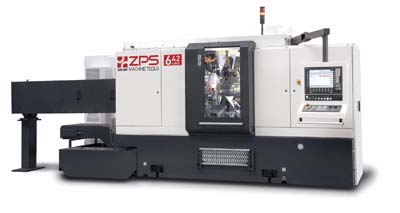ZPS 642
ZPS 642
ZPS America LLC has introduced the ZPS 642 CNC multispindle production center.

ZPS America LLC has introduced the ZPS 642 CNC multispindle production center. Provided with a double Siemens 840 D CNC, the rigid European-built machine offers up to 72 CNC axes and can perform nearly any metalcutting operation on precision parts from drilling and tapping to milling, hobbing, spline gears and broaching. The ZPS line offers very high processing flexibility and fast changeover with the ability to drop a variety of complex precision parts complete as either a bar-fed or chucker operation.
Across the spindles, a wide variety of precision metalcutting operations can be accomplished very quickly and without handling. The machine's flexibility is provided through its standard features: 6 independent AC-driven CNC horizontal spindles, 6 independent compound slides (X and Z), 6 independent tool carriers with driven tools, 5 backworking tools (3 driven), and a wide range of standard presettable VDI tooling for quick changeover to increase flexibility. Since the cutoff slide is an additional, separate slide, it reduces the backworking cycle time that is usually a limitation of multis'.
Additionally up to 5 Y-Axis with up to 185mm travel allow up to 15 driven tools for radial or frontal drilling, milling, turning or broaching. Since the drive is already part of the slide, the either driven or static quick change tool holders can be preset and changed within minutes. It is the patented state of the art designed spindle drive system, however, that sets the machine apart, according to the company. It is the key to the machine's precision, thermal stability, and high reliability.
According to tests performed at a technical university in Europe, the ZPS spindle drive system proved to be superior to other multispindle drive systems due to its mechanical precision and genuine simplicity. Each of the machine's six spindles is linked by a composite shaft to its own motor into the spindle drum, which employs a precise Hirth coupling. This makes it "unnecessary" to reverse-index the drum at the end of each 360-degree cycle, connect, and disconnect the motors to the spindles with each indexing, cool the drum to dissipate the heat generated by the spindles, or to supply power to the spindles through rotating, slip-ring connectors. It saves time, energy and cost and adds precision as well as reliability.
In addition this system allows for the strongest and most adjustable clamping power in the industry. You may set your spindle drives to the part or RPM you need. Therefore, you have actually three machines in one. You only have to change the standard drives, all of which can be done in a single day. This offers you from 10 to 52mm with optimal speeds and feeds. The mechanical rigidity and thermal stability are the reason for the built-in accuracy of the machine. Therefore, the use of refrigerant is not needed, which is what makes the ZPS machine so interesting to users.
Even without spindle compensation this machine tops the precision of its competitors. Using the built-in mechanical compensation allows for a new dimension of accuracy in CNC multispindle machines. Because hydraulics and refrigeration are eliminated in the spindle drum, the machine has a significantly higher uptime, has greater thermal stability, and as a result provides higher precision and efficiency than other CNC multispindles on the market. The innovative, patented technical solution developed by ZPS allows the independent control of the speed of each spindle and the power of each AC spindle motor according to the requirements of specific machining operations performed by each customer.
The machine is provided complete with all options and includes capabilities that make it effective on today's precision machining floors: quick changeover; simple, intuitive programming; single-point presettable driven tooling; quick-change tooling in all positions, and teaching software as well as a standard CAM programming software. A range of additional equipment includes a CNC pick-up spindle with up to 5 tools (3 driven) for backworking, attachments for radial and axial drilling and milling operations from cut-off slide, parts conveyor, bar stock feeding and high-pressure tool coolant system.
Also, the 5 real Y-axis, with up to 185mm stroke to attach 3 standard toolholders for driven tools. Over the last 5 years, high-precision, high-volume parts production is increasingly being handled by multispindle CNC machines, which offer the advantages of quick cycle times, the precision of a single spindle turning center, and rapid changeover to handle a wide range of parts.
"To help customers maintain trouble-free performance, we offer full preventative maintenance plans for each of our machines. Prompt factory service from local resident service and application factory engineers and factory warranted spare parts are very important to all our users," says Olaf Tessarzyk, Managing Partner and President of ZPS America. "The ZPS North American headquarters and factory is the sole source for ZPS cam-driven multi-spindle lathes and the line of TMZ CNC multi-spindle production centers."
All new machine sales, spare parts, maintenance, rebuilding and refurbishing, and factory trained local service come only through ZPS America in Indianapolis.





